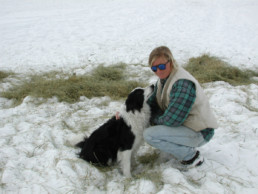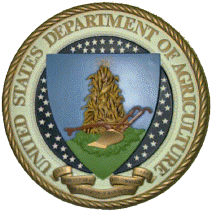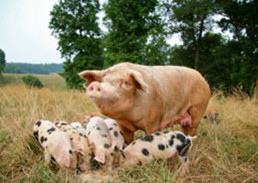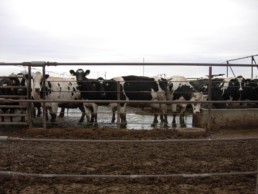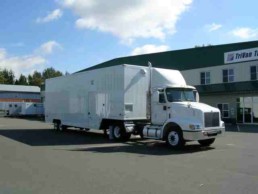The Farm Bill is Really A Food Bill
America’s first Food Stamps were orange or blue. Citizens eligible for government relief bought a one dollar orange ticket at face value, redeemable for any food item. Accompanying every orange stamp was a free blue ticket worth 50 cents, that could be used to buy surplus food items: meat, milk, eggs, or seasonal produce that the government purchased from farmers. This was the 1930s, and federal nutrition assistance, along with support to help farmers conserve the soil and earn fair prices, were essential elements of what we know today as the Farm Bill. Food stamps were what helped many desperate families put food on the table.
Eighty years on, Food Stamps continue to be one of the ways America grapples with its hunger problems. Paper coupons have given way to less stigmatized Electronic Benefits Transfer (EBT) cards—monthly monetary allotments assigned to a debit card. But the numbers are staggering. As a result of the economic contraction that started in late 2007, nearly 50 million people, one-third of them children, are now in poverty (up from 31 million in 2000). The number of U.S. citizens applying for food stamps, now known as the Supplemental Nutrition Assistance Program (SNAP), has nearly tripled since 2001. In the month of October 2012 alone, three years into our economic “recovery,” nearly 1 in 7 Americans—47.5 million people— participated in the SNAP program.
These monthly Food Stamp enrollment tallies, however, don’t demonstrate the magnitude of poverty in the U.S. or the true function of the program. Critics of big government and social assistance often use the Food Stamp program as a punching bag for wasteful, excessive and fraudulent entitlements. But the fact is, a majority of people use Food Stamps as a temporary safety net between jobs—not as a permanent solution to hunger. Many are working families struggling to raise themselves out of poverty. USDA estimates that as many as 65 million Americans received SNAP benefits for at least one month during 2012—1 in 5 Americans.
“People don’t aspire to enroll in the SNAP Program,” says Stacey Dean, of the Center for Budget and Policy Priorities. “By far, the SNAP Program serves people who, because of the stress and hardship of poverty, face a genuine lack of access to healthy and affordable foods.”
Even in the era of 99-cent value meals, Food Stamps play a crucial role in providing calories to hungry Americans. As the economic recovery drags on, and as deficit reduction talks heat up, the annual Food Stamp budget—which now totals $75 billion per year—will become a prime target for cost cutters. The values of food assistance must be part of those deliberations.
- Food stamps are part of the U.S. Department of Agriculture’s Farm Bill. While most people associate the Farm Bill with subsidies for corn and soybean farmers, in fact, its largest line item is the SNAP program, which accounted for more than 75 cents of every dollar spent by the Department of Agriculture in 2012.
- The Food Stamp program mainly serves people in need. The USDA’s official term for hunger is “food insecurity.” These are people who regularly skip meals because of a lack of resources. It could be a senior citizen, with hefty medical bills and fixed income, who must choose between medicine and food. Or it could be one out of every six American children for whom Food Stamps along with the School Lunch, Breakfast and Snack programs governed by the Child Nutrition Act, are an essential bridge between hunger and starvation.
- Many food stamp recipients have employment income. Over 60 percent of participating households earn income that they contribute toward the family food budget—it’s just not enough to stave off hunger.
4 . No one is buying filet mignon with food stamps. The maximum monthly allotment—$200 per individual and $668 for a family of four—nets out to around $2 per meal. Big city mayors, celebrity chefs such as Mario Batali, and others have taken on the challenge of living on a Thrifty Food plan for a week at a time. All have complained about temporarily foregoing caffeine, snacks, and things many Americans take for granted—and feared running out of money.
- Food stamps function as an economic stimulus. President Obama’s economic stimulus plan (the American Recovery Reinvestment Act of 2009) provided tens of billions of additional dollars for food assistance programs. Studies show that every Food Stamp dollar spent actually generates at least $1.74 in the broader economy. This is called a “multiplier effect.”
USDA Secretary Tom Vilsack regularly reminds audiences that the Food Stamp program helps farmers too. “Producers get somewhere between 15 and 16 cents of every food dollar that’s spent in a grocery store and a restaurant,” he told the American Farm Bureau Federation in Nashville in January 2013. “And to the extent that families are empowered during struggling times to be able to buy adequate groceries for their family, at the end of the day that also helps American producers.”
- Food stamps have a positive effect on health and nutrition. According to the Food Research and Action Center, the SNAP Program lifted nearly 4 million Americans above the poverty level in 2011 by boosting monthly income. Providing relief from hunger yields positive impacts on body weight, learning abilities, and reducing the incidence of chronic diseases—particularly among children.
The recent rise in Food Stamp enrollment offers an important window into the crisis of poverty and hunger in America. Some might view it as solid proof of failed economic policy. Instead we should look at as a way to assess whether and how government is doing its duty—investing in the health and well-being of all of society for the long term.
Clueless About Food and Agriculture?
Outside of First Lady Michelle Obama’s “Let’s Move” campaign to urge kids to exercise more and eat better, this administration remains largely indifferent to the disaster that is the country’s outdated food and agriculture policy. USDA Secretary Tom Vilsack recently argued that rural America has become politically irrelevant—a possible explanation for why the House refused to even consider a vote on a new Farm Bill last year. Maybe it’s something else. It could be that the present Congress and Administration are simply clueless about the severity of our food and farming crises.
Riding the coattails of the fiscal cliff bargain, the 2008 Farm Bill—three months past its “renew by” date—got a nine-month extension shortly after New Year’s Day. The extension could have included funds to preserve programs that help rural America and rebuild a food and farming system around the challenges of the 21stcentury. Instead, the policy—concocted in backdoor fashion without any public input—might as well have been written by lobbyists from the crop insurance, finance and agrochemical industries.
The Farm Bill extension bears little resemblance to the plan hotly debate and passed by the Senate last summer. While by no means ideal, that Senate plan would have clipped excessive commodity subsidies and reduced but still preserved important programs for conservation, organic agriculture, and rural development. This Farm Bill extension will continue sending $5 billion in direct payments to landowners whether they farm or not, whether they experience losses or not. (Both Republicans and Democrats favor eliminating such subsidies.) By extending rather than writing a new five-year Farm Bill, Congress did, however, manage to avert the dreaded “dairy cliff.” This would have reverted to a 1949 dairy subsidy program causing milk prices to spike to about $7 a gallon.
Kicking the Farm Bill down the road means we continue to invest in a backward agriculture policy. Because nothing was done to reform cotton subsidies, the US will continue to send $150 million in 2013 to Brazilian cotton farmers. This is the result of a lingering World Trade Organization ruling that declared previous US cotton supports trade distorting. Meanwhile, as Brazilian farmers benefit from the Farm Bill extension, the big losers are dozens of programs that train the next generation of US farmers and ranchers, invest in on-farm renewable energy, assist organic growers, expand farmers markets, and rebuild the infrastructure of a regionally-diversified food system.
Contrary to what many might think, the US faces a mounting list of rather alarming food and farming related challenges. Over 15 percent of the American population—mostly retired, disabled, children or underemployed—depend on food stamps, the largest budget item in the Farm Bill. Last year’s severe drought affected two-thirds of all agricultural counties, impacting crop yields, raising grain prices, and forcing livestock owners to sell off herds. Unpredictable weather patterns, we are told, are now the norm. “Superweeds” occupy 60 to 80 million acres of the country’s farmland as a result of a large-scale shift to genetically engineered, herbicide-resistant crops. Our research budgets into innovative farming strategies to address such problems are shrinking rather than expanding.
The Farm Bill exists to address problems, like these, that are not easily solved by the free market. A smarter Farm Bill would offer assistance to farmers to take care of natural resources, help for those who can’t get enough to eat, and funding for forward-thinking research to help farmers stay ahead of environmental challenges.
The good news is that the door is not yet closed on a Farm Bill. The most recent short-term extension means that a new five-year Farm Bill could be written and voted on by September. Despite “Farm Bill fatigue” setting in among many citizens who care about agriculture policy, the time to set the terms of this debate is now, as Congress struggles with the challenge of fiscal austerity and the national debt. We still have the opportunity to make the changes necessary for a healthier, more secure, and conservation-based food system. Representatives need to repeatedly hear our concerns.
Here are a few ideas that voters should be pestering the 113th Congress about:
Full funding for conservation programs to protect topsoil, clean air, fresh water and safeguard natural habitat;
Reform of the crop subsidy rules to exclude millionaires from government handouts and limit how much an individual entity can receive;
Changes to crop insurance including limits on federal funding to insurance companies and strict environmental stipulations for farming operations that enroll;
Expanded support for sustainable and organic agriculture through cost-share programs, research, and market development;
Continuation of programs that invest in a new generation of farmers and ranchers;
Initiatives aimed at increasing the accessibility and affordability of healthy nutritious foods, particularly among the young and aging.
Holding our collective breath for change won’t help. The healthy food movement needs to speak more loudly and preferably in unison on these issues. Otherwise we’ll get more of the same: food and agriculture policy that is clueless about the real problems we face in the years ahead.
Follow the Farm Bill discussions at
Sustainable Agriculture Coalition
PINK SLIME by Becky Weed
I am a farmer/I am a citizen, and this is what ‘we’ are being told:
We must raise or at least finish our animals in cages and feedlots because it is ‘more efficient’.
Even our animals that start on pasture must end in feedlots, because they ‘finish more quickly’.
We must feed heavy grain diets to ruminants evolved to live on grass, inducing low-grade illness and the practice of feeding subtherapeutic antibiotics --- because that ‘enhances growth rates’.
We cannot quit subtherapeutic feeding of antibiotics because it would be too expensive.
We must implant growth hormones to make our animals grow faster because that is most ‘profitable’.
We can extend the output of such feedlots by scavenging the meaty bits admixed with pathogen-prone fatty exteriors, and disinfecting the resultant ‘pink slime’ with ammonia gas. We must serve this augmented ‘hamburger’ to our populace, unlabeled, because it ‘adds value’.
We must spray chemicals on our fruits, vegetable, grains, and into our soils, because it is ‘cleaner’.
We must work, or hire others to work, in conditions that affluent Americans shun for themselves or their children.
We must burn up the carbon in our once-organic-rich soils in order to maximize production with ‘modern’ farming. We must displace food production with ethanol production because it ‘conserves’ carbon-based fuels.
We must purchase crop insurance via government programs rather than building our own crop insurance by building our soils and our crop diversity.
We must grow crops with diminished nutrients because modern, high-yielding Wonder Bread varieties are ‘best’.
We must feed the food derived from such management to our children.
We must plant only a few crops for fuel and livestock feed on such a vast portion of our continent that we disrupt the natural migrations of birds, mammals, pollinators, and water, because it is more ‘efficient’.
We must kill even our most iconic and remnant species, such as buffalo, because their vestigial grasslands interfere with our ‘system’.
We must degrade our waterways, air and soil with the effluent of modern agriculture, because it is most ‘efficient’.
We must purchase and plant the output of centralized biotechnology companies, because that is more ‘efficient’ than following a farmer’s curiosity, drive and wherewithal to breed seed suited to our local landscapes and cultures.
We should be grateful for the plentiful food thus produced, even if we observe increasing obesity diabetes, and malnutrition even among the ‘well-fed’.
We must be grateful for this ‘cheap’ food.
We must endorse these mandates of modern agriculture, while asserting that we are salt of the earth, and that we deserve to maintain our ‘way of life’ even as our food system degrades everyone else’s
If we choose to reject these mandates of ‘modern’ agriculture and farm differently, eat differently, vote differently, then we are quaint, callous, elitist and irrelevant.
We must feed the world, now seven billion, soon nine, then twelve, then what?
I am a farmer/ I am a citizen, and ‘we’ are telling us:
We are indeed grateful for the abundance, ingenuity and hard work that has brought us all much good food and good fortune, and it is time we take stock. How many compromises equal ‘modern’?
It is not our job to fill the Petri dish to bursting point.
The earth is our matrix and regulator. Neither trade associations, nor insurance companies, nor governments, nor universities, nor corporations, nor stock markets, nor our neighbors will superceed its natural systems’ ultimate grasp.
Perhaps some of us are too different to fit the rhythm of modern agriculture---too small, too poor, too new, too foreign, too female, too contrary, too dry, too wet, too close to the land?
Perhaps it is our job to lead the colony to pause, to feed our hearts and our brains, not just our bellies and our banks.
Efficient? Cheap? Robust? Equitable? Durable?
Farmers, of all people, could be the most qualified to recognize and explain that the current practices and trajectories take us to a place we cannot afford, and that we can scarcely want. That is, if we would speak our minds.
Pink slime is only the most recent manifestation, at the output end, of a more deep-seated, long-brewing slurry at the heart of American agriculture. This critique of the half-century-old corn-soybean-feedlot-dominated regime of American agriculture is not an attack on farmers, but is rather a plea to farmers, to awaken to our own complicity in, and our own power to change, the very system that we have allowed to compromise our values, our status, our land, and our futures. Pervasive propaganda notwithstanding, it does not have to be this way, because it cannot continue to be this way.
Have we entered Alice’s rabbit hole, where governors defend pink-slime manufacture for its job creation, even as the numbers of farmers, ranchers and cows continue to dwindle; where Farm Bureau policies perpetuate the dominance of a continental corn desert, even as their roadside posters invoke bucolic red barns and ranchers with calves-in-their-arms; where Monsanto patents life forms and prosecutes farmers, even as it bankrolls a $30 million dollar PR campaign to resurrect agriculture’s sullied reputation?
We have watched and sometimes profited in recent decades as the complex maze of subsidies, lobbies, markets, revolving doors and ignorance have rendered our legislative, executive and judicial branches impotent to find a path out. Consumers are trying to peer down the rabbit hole; scientists are tweaking the dials and reporting some news, but farmers, especially farmers, can and must blast open the portals and reclaim.
Becky Weed is co-owner of Thirteen Mile Farm in southwest Montana. Thirteen Mile runs a small wool mill and is currently revising its long-term sheep operation, collaborating with a young farmer to add vegetables to its lamb and wool marketing. Weed has worked on her own place and with others to raise livestock while coexisting with native carnivores. www.lambandwool.com/
Four Ways the Farm Bill Makes Me Crazy
The Farm Bill is a 700-page hodgepodge of laws, regulations, guidelines and payouts covering all manner of U.S. agriculture, conservation and nutrition programs. And by the end of September, Congress is supposed to re-authorize this mess, or some variant of it, for another five-plus years.
A rational, coherent blueprint for a healthy national food supply might be too much to ask. But after years of studying the Farm Bill, I'd be thrilled to see a dent made in four of its most glaring conflicts of purpose.
1. Don't subsidize what you don't want people to eat.
In broad strokes, the Farm Bill generally has three primary thrusts: 1. Nutrition spending like SNAP (formerly called food stamps), emergency food assistance, and school feeding programs; 2. Subsidies for commodity crops and income support for farmers; 3. Land, soil and ecosystem conservation. These first two are like trains on separate tracks running in completely different directions. (Come to think of it, so are the second and third. They will be addressed below.)
In early 2011, the USDA replaced its Food Pyramid with My Plate, a simple graphic representation of the food groups recommended. My Plate's message is clear: A healthy plate should be at least half full of fruits and vegetables and another 30 percent should comprise whole grains. The last 20 percent of the plate is reserved for proteins. A serving of low-fat milk or yogurt rounds off the serving recommendations.
If there were a matching USDA Subsidy Plate, however, its message would be: Fill your plate with meat and processed foods. Nearly two-thirds of the corn, over half of the soybeans, a great deal of the cottonseed and cottonseed meal, and even some of the wheat produced in the U.S. are fed to livestock. The remainder of the corn and soybeans are either processed into biofuel or industrial food ingredients. And these are the crops the Farm Bill primarily subsidizes. Fruits, vegetables and nuts--the very items the USDA wants us to eat most of--are known as "specialty crops" and currently receive only a small fraction of farm subsidies despite their high nutritional values. Well over 60 percent of commodity subsidies flow to crops fed to animals.
It's the industrial beef, hog, chicken and dairy operations that win out; subsidies mean they get cheap feed. According to the Physicians Committee for Responsible Medicine, the meat, egg and dairy sectors were the beneficiaries of the majority of the $246 billion in subsidies given to U.S. food producers between 1996 and 2009.
2. Don't pay polluters.
Massive dairies, hog and poultry factories and other livestock feedlots house thousands (often tens or even hundreds of thousands) of animals. Some produce as much waste as the sewage system of a small city. The difference is that animal feeding operations don't install municipal waste treatment plants to clean up their messes.
And yet this type of food production has been supported for a decade by a Farm Bill program called the Environmental Quality Incentives Program. EQIP, as it's called, must spend 60 percent of its budget on livestock producers, many of whom are the worst, environmentally speaking. And what are they spending that money on? Manure lagoons and waste trafficking.
EQIP started as a conservation program, meant to help small livestock producers keep animal waste out of creeks and waterways. But now, thanks to lobbying, the massive animal farms can be reimbursed for up to 75 percent (capped at $300,000 per owner) of their costs for animal waste storage and hauling and compliance with laws like the Clean Water Act. Should we have to pay livestock operators to comply with basic laws? Should our tax dollars build the infrastructure for massive meat, egg, and dairy factories?
Meanwhile, EQIP funds to organic farming projects are capped at $20,000 a year per operator.
3. Don't subsidize overplanting.
Nothing in the Farm Bill--nothing--continues to be more counterproductive than the complete disconnect between commodity crop subsidies and conservation programs. On the one hand, subsidies encourage farmers to plant in every inch of soil, crop insurance programs eliminate farmers' economic risks, and disaster bailouts encourage plowing even on marginal lands in areas prone to flooding and drought. On the other hand, the U.S. Department of Agriculture directs less than 7 percent of its overall spending toward conservation, much of that to right past wrongs and to clean up problems stemming from over-farming.
Consider, for example, that even as 1.7 million acres were enrolled in the Conservation Reserve Program in South Dakota between 1985 and 1995, more than 700,000 acres of grassland were converted to crops--primarily corn and soybeans (already in excess supply). This absurd process only accelerated during the last Farm Bill, as even grasslands used for hay and pasture were transformed into corn fields. Such a dichotomy makes Farm Bill conservation programs seem more like a distraction than a coordinated national stewardship strategy.
In the case of the Wetlands Reserve Program--arguably the Farm Bill's most successful conservation effort to date--only wetlands previously impacted by agricultural development are eligible for funding; you can't use the money to save pristine ecosystems (unless they're attached to land damaged by farming or ranching).
4. Don't farm corn for fuel.
The drums are finally beating against ethanol subsidies and tax breaks that suck up $7 billion per year in tax dollars. It's about time. For years Congress has mandated that gas be blended with ethanol to push our fuel supply further. And yet, we're practically spinning our wheels backwards. It takes about two-thirds of a gallon of petroleum products to sow, fertilize, irrigate, harvest and process a gallon of corn ethanol. That's minimally cutting our dependence on foreign oil.
In fact, in 2010 a full 36 percent of the U.S. corn crop was turned into ethanol. That only displaced about 8 percent of what we put in our gas tanks. Americans could save that much gas with a 1.1 mpg increase in the fuel efficiency of our cars and trucks. Here's a kicker: Ethanol-laced gas actually lowers fuel efficiency by 3 to 4 percent.
America faces numerous and complex food- and farming-related challenges in the years to come: curbing the obesity epidemic, halting the loss of habitat, stopping disease outbreaks like e. coli, bringing up the next generation of farmers and ranchers, and many more. The Farm Bill is our chance to right things that are wrong with the food system. Even small amounts of well-directed funding can do a great deal for a beginning farmer education program, habitat restoration effort, or local food project. It would help if the Farm Bill could stop fighting itself. And maybe then it can start to align along one sensible strategy: Create economically and environmentally healthy farms to grow healthy and affordable food.
A West Coast Healthy Food Uprising
The West Coast is a place where, on a rainy winter night, hundreds of people turn out to discuss food policy. People understand the connection between healthy food and community health. They see local and regional food as an engine to revitalize economies. Still I am often asked what audience members can do to affect change in the food system.
To my mind, individual action takes place in radiating circles, starting with the personal and moving out to the local, regional, state, national and global. I am increasingly drawn to the personal and local, where influence and outcomes are most powerful and tangible. Raise your own fruits, vegetables, or chickens and you know exactly what goes into the entire process. Work on a campaign to protect open space or build a school garden and you can have personal contact and investment.
Things are not so clear or accessible at the national level. The Farm Bill, driver of federal food policy, is so complex that it is hard to know where to begin. Absent campaign finance reform, you are swimming with the sharks: grain monopolies, corn growers, farm bureaus, livestock associations, sugar lobbies, ethanol processers that pour billions of dollars into the political process.
We can’t let this intimidate us from righting a broken food system. By pulling back to the regional level, it might be possible to form an alliance of concerned eaters with political power at the national level. In January 2011, the City of Seattle approved a Farm Bill platform. Given the growing awareness of the importance of food and farm policy on the West Coast, it is reasonable to expect that city councils in Olympia, Portland, Eugene, Ashland, Ukiah, Santa Rosa, San Francisco, Los Angeles and all the way down to San Diego may carefully consider and eventually sign on to a similar document. Its main tenets share a lot in common with a Farm Bill platform drafted by Roots of Change in Los Angeles in November 2010:
- a health centered food system;
- sustainable agriculture practices;
- community and regional prosperity and resilience;
- equitable access to healthy food;
- social justice and equity;
- systems approach to policy making.
While the Farm Bill is the Big Kahuna in the food and agriculture system, there are other forceful unifying levers. In 2008 California passed Proposition 2, an animal welfare initiative that will ban three forms of egregious confinement systems: cages for laying hens; confinement stalls for pregnant sows; and veal crates for male dairy calves. Proposition 2 can’t be dismissed as a purely California phenomenon. It passed with 63 percent of the vote. Seven states have now banned certain animal confinement systems, and the Humane Society of the United States has introduced similar initiatives in two more key states: Washington and Oregon.
In addition to unified Farm Bill platforms, imagine the entire West Coast agreeing on advanced animal welfare standards. Most citizens believe that food animals deserve humane treatment while they are alive, yet there are no laws at the national level to protect livestock during their production cycles. Intervention is still possible at the state level.
Health practitioners are also joining the food policy reform movement, concerned about the epidemic of obesity, diabetes, heart disease, and other nutritionally related ailments ravaging adults and children in their communities. They are following the lead of innovative programs like the California Farmers’ Market Consortium that links the food stamp program (SNAP) with regional growers of fruits and vegetables in 60 farmers markets, from Santa Rosa to San Diego. In key markets, SNAP recipients can receive up to double the value of their purchases of fruits and vegetables—money that goes right into the hands of farmers. They can also watch demonstrations on how to cook and eat more healthfully. Doctors are collecting data on the medical benefits of such programs to analyze their effectiveness.
Coastal livestock producers and consumers interested in high quality, pasture-raised animal food products are united around a common concern: a lack of slaughter facilities within reasonable driving distances from production centers. In years past, each large town had some sort of slaughter facility. But decades of massive consolidation have devastated local processing capabilities. Small-scale slaughter facilities are one of the crucial missing links in local food system capabilities. In California, for example, only a handful remain. Just as Farm Bill dollars once built the giant monoculture farming infrastructures and Concentrated Animal Feedlot Operation industry that dominate today’s food system, it can do the same for the modern pastured livestock movement. Assistance can come in the form of value added producer grants, loans, important research, regulations tailored to small-scale facilities—to complement necessary private investment. Reformers could ask for 10 new West Coast processing facilities, for example, in the upcoming Farm Bill as a pilot project.
In a relatively short amount of time Washington, Oregon, and California could become a regional force in the national dialog leading up to the next Farm Bill. If we citizens don’t impact policy at the national level, there are plenty of agribusinesses and food manufacturers already working to set the rules and spend taxpayer money for us. As the old adage says, we reap what we sow. The West Coast can set its own table.
What Industry Doesn't Want You to Know About Animal Factories
See no evil, hear no evil, eat no evil. This seems to be the operating principle behind a slew of recent legal initiatives aimed at sheltering animal factory agriculture operations from public view.
State legislatures in Iowa, Minnesota and Florida are now considering bills that would make it a criminal offense to gain employment for the purposes of videotaping what goes on the behind warehouse walls of Concentrated Animal Feeding Operations, or CAFOs. In March, theIowa House of Representatives passed such an anti- “whistle blower” measure, co-written by the Iowa Poultry Association, which is now before the State Senate.
Pre-emptive legal strikes by the CAFO industry to put a chilling effect on anyone considering tarnishing its public image are hardly surprising. Industrial animal food producers are reeling from a series of shocking undercover videos that expose the abuse and suffering on the disassembly lines of slaughterhouses and inside warehouses crammed with hogs, laying hens, and meat birds. Such imagery is hard to shake from your subconscious. (Just this week a video was released of a sick calf getting killed with a pickaxe.) Opinion polls consistently show that Americans are increasingly concerned about animal welfare and health standards, and often willing to pay more for them.
While the industry would like us to believe that what you don’t know can’t hurt you, we are barely six months removed from last summer’s recall of 500 million eggs due to salmonella contamination from just two CAFO operations in Iowa. In response, people flocked to farmers markets, specialty retailers, and other venues to purchase free-range, organic, and cage-free alternatives.
In fact, industrial animal agriculture has already made bold assaults against First Amendment rights. In three states—Kansas, Montana, and North Dakota—it is illegal to photograph a factory farm without permission of the owner. Thirteen states have passed agricultural disparagement laws—a.k.a. veggie libel laws—that restrict what can be said about perishable food products. None of these laws have been challenged in federal court. The Texas Cattlemen’s Association, however, engaged Oprah Winfrey in a prolonged legal battle in the late 1990s for claiming on television that she had been “stopped cold from eating another burger” after learning about cattle feeding procedures from reformed rancher Howard Lyman. The popular talk show host had both sufficient resources and determination to fight and ultimately won the decision.
Numerous states have passed Common Farming Exemptions, which essentially allow the industry to determine animal cruelty statutes by defining them as standard practices. Does this sound like the fox guarding the henhouse? While the welfare of our pets is legally protected, there are no federal laws that presently govern the raising of food animals. Food animals are protected during transport (very hard to enforce) and during slaughter (though this doesn’t include the 9 billion chickens raised in the United States each year.)
The real question citizens and our elected representatives should be asking is, what do the animal factories have to hide, and do we really want to be part of such a clandestine food system? Is a cheap bacon cheeseburger or bucket of chicken worth the loss of democratic freedoms? We are talking about food production, after all, not missile defense.
Dr. Temple Grandin, animal behavior specialist at Colorado State University and long-time consultant to the livestock industry, argues in her most recent book, Animals Make Us Human, for greater transparency. Animal food producing operations, she suggests, should be able to pass a random inspection test, where a non-expert can visit and intuit how well animals are being treated. The best facilities, in her opinion, have video cameras streaming at all times, allowing for constant monitoring. Dr. Grandin is far from a radical animal welfare activist, and remains one of the most respected people in the world on such matters.
Animal agriculture impacts the planet in powerful ways. Tens of billions of food animals consume vast amounts of feed, generate massive volumes of waste, and make cheap fat and cholesterol laden meat, eggs, and dairy products the centerpiece rather than a vital component of every meal.
Proponents have been arguing for years that industrial food production is necessary to feed the word’s ever-increasing population. Essentially we are being told that the CAFO industry is too big to fail. Research increasingly shows that modern sustainable agriculture operations can be equally or more productive than conventional ones: without federal subsidies, environmental impacts, and dubious health implications—or infringements upon constitutionally protected freedom of speech.
Organic and sustainable agriculture practitioners have spent the last thirty years with an open source approach to information about farming techniques. For the most part, what they have learned the hard way about chemical-free, soil enhancing agriculture is out in the open for anyone to learn. Certified organic and biodynamic producers are required to pay fees to third-parties to audit their practices.
Recent moves to pre-empt the public from learning about the sometimes unspeakable conditions of modern intensive livestock operations are just the tip of the iceberg. Local communities are being stripped of their powers to determine zoning and land use concerning agricultural operations. Why aren’t local citizens permitted the right to decide whether a CAFO can be sited in their community in states like Illinois and Iowa?
There is a lot more information that the consuming public might find useful about industrial animal food production: the quantity of antibiotics used during a given production cycle; the exact contents of feed rations; the quantities, content and dates of air and water emissions from a CAFO; the amount of federal subsidies that support a particular operation. All are concerns with real public consequences.
We all have to eat. But we also have a right to know. Food should not come at the expense of animal welfare, the health of someone else’s community, or perhaps most importantly, our democratic freedoms.
Honoring The Food Animals On Your Plate
From the cream in our Monday morning coffee to the roast chicken at Sunday night dinner, we accrue an incalculable debt to food animals. We depend on them for nourishment. We gather festively around the cooking of a turkey or ham during holidays. Yet many people do not realize that most of the animals that grace our tables are the victims of harsh suffering long before slaughter.
Consider the modern turkey. It is far removed from the wild, native bird that the pilgrims roasted for those original Thanksgiving gatherings. Today’s conventional turkey, the Broad Breasted White, is an entirely industrial creature. It is bred to grow freakishly quickly and raised on grain inside massive buildings. Most male turkeys, or Toms, become so breast heavy, they can barely stand up – and certainly can’t reproduce. Artificial insemination is the only way this man-made species survives.
Such mass-production meat factories – called “concentrated animal feeding operations,” or CAFOs – exist for most of the animal food products Americans buy: cows, pigs and chickens. At least 90 percent of food animals in the U.S. are raised this way, and other countries are rapidly adopting the CAFO model as well. These enterprises are a perverse inversion of our idea of family farms with pigs rolling in the mud, cows grazing in pastures, roosters crowing from fence posts, and farmers interacting with the animals. At CAFOs, vast numbers of animals—100,000 cows on a feedlot, 30,000 chickens in a broiler shed, 1,000 hogs in a windowless warehouse—are confined in pens or cages, often kept alive with regular doses of antibiotics.
As CAFOs take over the food system, it is clear that there is already plenty of animal protein in our diets. Americans now eat an average of 33 pounds of cheese each year, for example, largely because of the flood of cheap milk coming from dairy CAFOs. This is three times the per capita consumption of the 1970s. Cheese is the largest source of saturated fats in our diets, which tend to raise cholesterol levels and are linked to heart disease. Dairy products, meat, poultry, and eggs don’t have to be nearly so cheap or abundant – and yet we are raising 10 billion food animals in the United States every year.
The high costs of factory-farmed foods are being paid for by the animals, rural communities, taxpayers, and the environment. Large-scale animal operations generate the sewage output comparable to a small metropolis.The waste oozing from these highly concentrated production systems fouls the air, land, and water. Sadly, if you purchase animal products from fast food restaurants, supermarkets, big box stores, or other mainstream outlets, there is a strong chance that you are eating at the expense of someone else’s community well-being.
You don’t have to become a vegan or vegetarian to opt out of this system that might best be described as “organized irresponsibility.” (Those are certainly viable options, however.) Some of the country’s best small farmers are demonstrating that traditional methods of livestock production are practical and economically viable. They are raising locally adapted breeds of livestock on pastures where the animals eat a more natural diet, grow more slowly, and naturally socialize. These animals are also raised without routine doses of antibiotics and growth hormones, essential tools in industrial CAFO production. Third-party certification organizations such as Animal Welfare Approved have established standards combined with regular audits to encourage such humane production practices.
Still, labels can be confusing, and some like “natural” and “healthy” are misleading. The best way to know where your food comes from and how it was produced is to know your farmer.
The other way to reduce the role of CAFOs is to scale back the amount of meat we consume. Many individuals are simply orienting their meals around more grains and vegetables with smaller portions of higher quality, sustainably sourced meats, dairy, and eggs. Another groundswell is the Meatless Monday campaign, which has already been embraced by chefs, restaurants, food services, k-12 schools, and college campuses.
Attending to the conditions under which your food is raised is a profound way of giving thanks to the animals that nourish you daily. It can also lead to some of the most satisfying meals you’ve ever shared or tasted.
Resources:
CAFO: The Tragedy of Industrial Animal Factories
Grass Pastured Meats
This piece was originally published on Huffington Post.
Confessions of a Reluctant Wonk
First, a confession. I am a reluctant wonk. Despite writing rather extensively about food and agriculture policy, acronyms are not what motivate me in the morning. After about a half an hour of studying something as dense as the Farm Bill, I need a diversion, a few minutes of deep breathing outside with my feet on the ground, or some quality time with Fanny, my Australian shepherd.
I do believe that agriculture is indeed a public good. Food and farm policy are not a necessary evil but a real privilege and opportunity for a country and its people. It is wise to invest in conservation, clean water, soil protection, and habitat enhancement for our collective good. The natural world, well attended, cannot keep pace with the growth demands of the industrial economy and Wall Street. Unfortunately, our rural lands, farm animals, and agriculture workers are being driven by efficiency, industrial concentration, and profit taking. Rather than investing in tangible returns and long-term security, agriculture policy is pushing us toward the brink of collapse on many fronts.
For those who care about healthy food, the Farm Bill is something we all need to digest—even in small helpings. The information is out there, accessible and more organized than ever before, even if the situation is not so rosy. (Check out www.farmpolicy.com everyday for a week to get started.)
The Farm Bill is a massive legislation that is revisited every five to seven years. The next renewal is scheduled for 2012 but it could likely drag on into 2013 or beyond. For the last few decades the Farm Bill has been dominated by two primary political forces: a nutrition and hunger bloc that fights for food stamps (now known as SNAP) and other assistance; and the commodity agriculture lobby (corn, cotton, wheat, rice, soybeans, dairy, sugar producers, and concentrated animal feeding operations or CAFOs). This is your basic quid pro quo. Urban legislators get food assistance for the 40 million Americans facing hunger on a regular basis. Farm country legislators bring home the bacon to huge agribusinesses that are now raking in record profits.
My least favorite of these commodity players hijacking taxpayer dollars are the CAFOs. Not only are their factory animal farms morally reprehensible, they are fouling the air, water and land in the communities where they have taken over and are feasting at the public trough in the process. Their economic model is based upon a steady supply of Farm Bill subsidized feeds—corn and soybeans—that has saved them billions of dollars over the last decade. (This is well documented in a report by Timothy Wise and Elanor Starmer from Tufts University). In 2002, the CAFO industry began raiding precious Farm Bill conservation dollars to pay for nasty manure lagoons and waste management infrastructure. A single CAFO investor can qualify for $450,000 in Environmental Quality Incentive Program dollars to pay for his or her own pollution compliance. (Read Martha Noble’s essay inThe CAFO Reader for a more detailed summary.)
One would think that once the CAFOs and other commodity producers get their 10 billion to 20 billion dollars each year from the taxpayers, their lobbyists would be content to let the rest of the players fight over the scraps: a few billion here for conservation, a few million here for rebuilding local food capacity, a few million for those organic farmers who pay high certification costs just to prove they are doing the right thing. But agribusiness is not content. They are fighting for every last cent of Farm Bill dollars and doing all they can to paint the burgeoning good food movement as fringe and meaningless.
Last year, Senators Mc Cain (R-AZ), Chambliss (R-GA) and Roberts (R-KS) publicly attacked Secretary of Agriculture Tom Vilsack and a small program named Know Your Farmer, Know Your Food. KYF 2 (in Wonk speak) was spending approximately $65 million to rebuild local food systems around the country, including developing new markets in urban areas for rural farmers hoping to expand their businesses. In highly divisive language, the Senators claimed that this money was benefitting organic hobby farmers supplying urban elites at farmers markets, rather than “Production Agriculture.” This is the term for heavily subsidized monoculture commodity farmers that largely grow crops we don’t directly eat. Just to give some perspective on that $65 million Know Your Farmer program budget, Brazilian cotton farmers received $165 million last year from our government in retaliation for past U.S. cotton subsidies deemed illegal by the World Trade Organization. The Senators wrote no nasty letters to the Secretary about those payouts to farmers in another country as far as I know. Then again, there are a lot of cotton farmers in Arizona and Georgia.
Last week the rules were finalized on another 2008 Farm Bill program called the Farm and Ranchland Protection Program (FRPP). One would hope this money would go to protect beautiful farmlands in areas threatened by sprawl and development. But in keeping with their strategy of fighting for every last cent of the Farm Bill pie, agribusiness lobbyists were able to make a CAFO manure lagoon (a cesspool of waste) eligible for protection under Farm and Ranchland Protection Program easements. Maybe there is something I don’t quite understand — such as even small operations have such holding facilities — but somehow this doesn’t seem what the program was intended to preserve. (Read the National Sustainable Agriculture Coalition’s report here.)
As you can see, foodies, foodists, healthy food activists, and concerned citizens have no choice but to begin to understand the detailed maze of farm policy. Our challenge is to move from acting individually to developing collective clout. It’s the only way voting with our forks might begin to change the enormous power corporate agribusiness wields over our food system.
Down on the Factory Farm: The Lower Yakima Valley
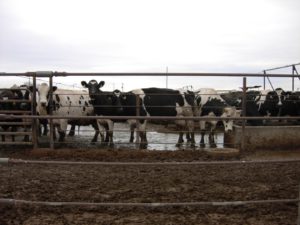
 With a slate gray sky threatening rain on an early November day, I drive up to the Lower Yakima Valley to meet anti-factory farm activist Helen Reddout. She is the founder of Community Association for Restoration of the Environment (CARE), a group that has battled industrial dairies in southeastern Washington State for over 15 years.
With a slate gray sky threatening rain on an early November day, I drive up to the Lower Yakima Valley to meet anti-factory farm activist Helen Reddout. She is the founder of Community Association for Restoration of the Environment (CARE), a group that has battled industrial dairies in southeastern Washington State for over 15 years.
An older woman of smallish stature, Reddout doesn’t look like your typical public defender (if there even is such a thing). She is in fact a farmer and still runs the cherry business she started with her husband many decades ago.
But it only takes 5 minutes for me to realize that Reddout has done a lot of homework and is not afraid of confrontation. In the mid-1990s, she explains, as we pile in the car to start our tour, an influx of mega-scale dairies, primarily from southern California, tragically transformed a valley with a diversity of small family farms into a toxic nightmare. At first she thought the agencies would deal with the perpetrators and the sewage that immediately began to overwhelm her rural community. One day she realized that they weren’t going to take action and began to fight back.
The remnants of that former patchwork of diversified agriculture are still visible in the Lower Yakima. Feathery fields of asparagus now golden and red, the heavy bushes tilting towards winter dormancy. Orchard blocks of cherry, apple and pear trees. Stubble and angled stalks from fields of feed corn now harvested. Increasingly what we see dominating the farm economy here, however, are huge operations with very large concentrations of black and white Holstein dairy cows.
The cows are not out grazing in the green rolling pastures. Some operations have shiny aluminum siding, cement floors, and stall systems that stretch on for hundreds of yards like municipal airport hangers. At others, the cows are confined in open corrals on vast manure and muck lots, spending the day walking and standing in their own waste. Adjacent to all these pens and enclosures are manure cesspools of all kinds. There are concrete holding tanks, unlined lakes brimming with sewage, massive pits carved into the earth waiting to be filled. There are more than 200,000 cows on the 70-plus CAFOs in a 19-mile corridor in the area, estimates Reddout. But she encourages me to call around to the local agencies, because she says even they don’t know how many cows are actually in the valley anymore.
At approximately 125 pounds of waste per cow per day, you begin to get the brutal picture of what it’s like to have your community taken over by industrial dairies. It seems as if you combined all the liquid waste from the dairies we drive by, it could easily fill a stadium. Manure is being sprayed on surrounding fields through large central pivot irrigation booms and smaller manure cannons, pumped from one holding area to another. As the storm touches down, the shit smeared fields begin to glisten in the rain. The waste enters my senses through a variety of pathways: burning nose, throbbing temples, nauseous stomach. One can easily imagine manure ponds overflowing, fields saturated, and waste literally running into ditches and along roadsides. No wonder property values have plummeted and real estate sales have stalled out. Many residents couldn’t move even if they want to.
The entire system seems to be predicated on organized negligence. There is clearly both too much waste and too much milk. Reddout tells us that with the national glut of milk, much of the output here will be exported or dehydrated or made into cheese. Meanwhile the kids in the local schools are at risk of their water supply being contaminated by e.coli or nitrates. Most of the small dairy farmers have been driven out by the big corporate dairies who concentrate more animals on their lots for ever-diminishing returns on bulk milk prices. Starlings and magpies flock around these operations, becoming unwitting transmitters of mold and bacteria around the community. Then there is the issue of replacement calves. In order to continue lactating, milk cows must be impregnated every year. Half of the calves will be male and have little economic value. At the end of our tour we pass a hovel of plywood containment huts where male calves are tethered for veal production. Through small cutouts in the wood, you can see the eyes of a few animals staring out.
In 2002, CARE was awarded a $1 million decision against a local dairy operator for violations of the Clean Water Act. Half the money went to the Western Environmental Law Center in Eugene, Oregon, the legal defenders who took on the case; the remainder went to an organization that conducted an extensive study of well and groundwater quality throughout the entire valley. Meanwhile the fight goes on and the industry searches for ways to expand the number of cows in the valley.
The latest scam involves raising millions of dollars in public funds to install industrial digesters on top of the waste pits that capture methane gas for energy conversion. It’s a concept sold to the public as a green energy solution, even if the millions of taxpayer dollars invested may never be recouped, and nitrates may still pollute the environment, and the industrialization of the dairy cow will continue.
Before I head back to the safety of my own community, I ask Helen Reddout what she wants. Without hesitation, she tells me she wants the dairy CAFOs to leave her community for good and for family farming to return to the Lower Yakima. The routine use of antibiotics whether animals need them or not, she argues, should be stopped, as it leads to the proliferation of antibiotic-resistant pathogens that threaten human and animal health. She wants the federal subsidies that provide cheap grain to CAFO operators and other taxpayer supports eliminated. And she wants to see any remaining dairies to follow the lead of her neighbor Allen Vourtman, who grazes 350 cows on pastures next to her home, and takes the welfare of his cows, and their impacts on the health of the local environment very seriously.
From what I've seen, Helen Reddout doesn’t seem to be asking too much.
For a great article on the dairy industry and the USDA from Pulitzer Prize winner Michael Moss, read this piecein the Nov. 6, 2010, New York Times.
"Know Your Farmer" Program targets small-scale, rural meat producers for assistance
This Blog post was written by Emmett Hopkins, a Northern California vegetable farmer (Foggy River Farm) and Watershed Media research assistant.
Critics have accused the USDA's new "Know Your Farmer, Know Your Food" program of siphoning money from rural farming areas to prop up "urban locavore markets." As a farmer, I feel the opposite is true. The program is specifically looking for ways to create more agricultural opportunities in rural areas by removing barriers to small-scale farming.
As described in a previous Watershed Media blog post, a trio of Republican senators, including John McCain, recently wrote a letter to Secretary of Agriculture Tom Vilsack complaining that the program is "aimed at small, hobbyist and organic producers whose customers generally consist of affluent patrons at urban farmers markets.” The subtext of this statement is this: the "Know Your Farmer" program is supporting small-scale meat and vegetable farmers who sell directly to consumers instead of big agribusiness farmers that grow commodity crops like corn, soy, and factory-farmed animal products. And in this the senators are right; "Know Your Farmer" is trying to make it easier for small-scale, rural farmers to survive.
Small-scale Meat Producers & Mobile Slaughter Units
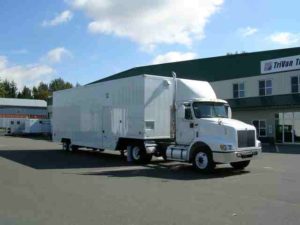 Funded under "Know Your Farmer," the USDA has recently rolled out a series of tools to promote small-scale meat processing in rural areas. At a time when the vast majority of the meat industry is controlled by three or four multinational corporations, local processing facilities are sorely needed. In many regions, animals farmers would currently have to trek their livestock across state borders to find the nearest state or federally approved processing facility. A study funded through "Know Your Farmer" shows all the geographic gaps between the country's meat producers and the facilities that can legally process their chickens, steers, and hogs. The study's charts show hundreds of counties with no nearby options.
Funded under "Know Your Farmer," the USDA has recently rolled out a series of tools to promote small-scale meat processing in rural areas. At a time when the vast majority of the meat industry is controlled by three or four multinational corporations, local processing facilities are sorely needed. In many regions, animals farmers would currently have to trek their livestock across state borders to find the nearest state or federally approved processing facility. A study funded through "Know Your Farmer" shows all the geographic gaps between the country's meat producers and the facilities that can legally process their chickens, steers, and hogs. The study's charts show hundreds of counties with no nearby options.
To help close these gaps, the USDA is promoting mobile slaughter units--essentially butchers on wheels, able to travel from farm to farm to process meat where it wouldn't otherwise be possible. There are currently only nine such roaming facilities in operation in the U.S. (4 in Washington State and one in Alaska, California, New Mexico, New York and Texas). A group of farmers in San Juan County, Washington organized the first of these mobile less than ten years ago. The 36 foot truck and trailer unit began accepting animals for processing in 2002. It can process 10 beef, 24 hogs, or 40 sheep per day with two butchers.
According to Neil Gaffney, press officer for the Food Safety and Inspection Service, "mobile processing facilities are viewed by the USDA as one mechanism that helps support the goals and objectives of 'Know Your Farmer, Know Your Food.'" To help spur more development of mobile slaughter units, the USDA has taken the following steps (as detailed by Gaffney):
- FSIS launched a toll free help desk last December for small meat and poultry processors, which will support USDA's "Know Your Farmer, Know Your Food" initiative by helping small processors to reduce the time and expense of dealing with agency requirements.
- FSIS held outreach webinars this past January on mobile slaughter units, and produced a video to help prospective producers with the requirements on setting up a mobile slaughter facility.
- In May, as part of the Know Your Farmer, Know Your Food initiative, the Agency announced the availability of the FSIS compliance guide for mobile slaughter units (available at www.fsis.usda.gov/Significant_Guidance/index.asp), a document that can help small processors and establishments who own or manage mobile slaughter units meet food safety regulatory requirements.The document is not a regulatory requirement.
- FSIS also released a preliminary study as part of that initiative in May revealing existing gaps in the regional food systems regarding the availability of slaughter facilities to small meat and poultry producers. The data in the study creates a county-by-county view of the United States, indicating the concentration of small farms raising cattle, hogs and pigs, and chicken, and also noting the location of nearby state slaughter facilities and small and very small federal slaughter establishments. (See "Slaughter Availability to Small Livestock and Poultry Producers – Maps" at:http://www.fsis.usda.gov/PDF/KYF_maps-050410_FOR_RELEASE.pdf.)
- On June 24th, the Agency hosted a red meat mobile slaughter unit information session at the Washington County Agricultural Center in Boonsboro, Maryland, to educate farmers, ranchers and processors on how to set up mobile slaughter units, receive the federal grant of inspection and meet USDA food safety requirements.
The hope is that, over time, these efforts will help build the infrastructure needed to support small-scale, regional meat producers.
But why is it important to help small-scale farmers in the first place?
In today's agricultural arena, small-scale, family farms are routinely being squeezed out by corporate operations. In several years' time, we may be hard pressed to find more than a hand full of small, independent growers. According to a recent Worldwatch report, only four companies control 60 percent of terminal grain facilities. Cargill, Archer Daniels Midland, and Zen Noh control 81 percent of U.S. corn exports and 65 percent of soybean exports. And three companies--JBS, Cargill, and Tyson together dictate over 75 percent of the U.S. beef market and four companies more than 65 percent of the U.S. pork market. Chicken and turkey are not far behind. In almost every agricultural sector--from meat production and processing to fresh fruits and vegetable farming--the little guy is becoming an endangered species.
The USDA is wise to identify this trend as a potential long-term problem and take steps to stop the bleeding. Agricultural consolidation poses major risks to both our food safety (outbreaks are hard to track in the factory-farming model) and our food security (if we delegate all our agricultural resources to a few companies, we're more likely to lose them.) Corporate consolidation also threatens to dismantle the rural communities that have formed the bedrock of the nation for centuries. As agriculture becomes more and more large-scale and mechanized, farmers find themselves out of work and farming communities have to shutter their doors. To combat this, Neil Gaffney says, "the initiative is working to break down barriers that keep local food systems from thriving, and create new opportunities for farmers, ranchers, consumers and America’s rural communities."
For information about all the mobile slaughter units around the country:http://www.extension.or/page/Mobile_slaughter%2Fprocessing_units_currently_in_operation
For photos and video of mobile slaughter units:
http://www.mobileslaughter.com/photos.htm
Slow Food USA article on Mobile Slaughter Facilities and Food Safety:
http://www.slowfoodusa.org/index.php/slow_food/blog_post/mobile_slaughter_facilities/
Deputy Secretary of USDA, Kathleen Merrigan, on Mobile Slaughter Units:
http://brownfieldagnews.com/2010/01/25/merrigan-says-mobile-slaughter-units-have-a-role/





